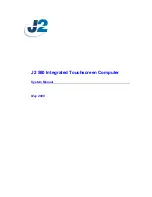
Smart 1-Line
TM
Page 42
The following items are important for general troubleshooting and/or common reasons for issues.
•
Communications status box. This box appears in the lower left corner of the Smart 1-Line
when it is in Run Mode. Refer to Section 4 for additional information.
•
Trip unit power state: In order to provide RS-485 Modbus communications, trip units must
be powered by breaker current, voltage (via VDM or PT module), or auxiliary power.
Example: if an AC-PRO-II (without VDM) is installed, no current is flowing, and no external
auxiliary power is present, then the trip unit is not capable of RS-485 Modbus
communications.
•
Address programming: Each trip unit must be programmed with a unique Modbus address.
This Address is set at the trip unit. Two (2) trip units on the same RS-485 network cannot
have the same address. The Smart 1-Line Designer Mode should be programmed to have
one (1) breaker per trip unit address.
•
Communications settings:
o
Baud rate: All connected trip units and the Smart 1-Line must be programmed/set
to the same Baud Rate. AC-PRO-II trip units have an adjustable Baud Rate.
AC-PRO units (that are equipped with optional Modbus communications) have a
fixed Baud Rate of 9600.
o
Timing Settings, Modbus Settings, and Modbus Server Settings:
The Smart 1-Line has several settings that affect communications. See Section 3
for additional information.
•
RS-485 Network wiring
o
Network wiring integrity: If you are troubleshooting a network that is being tested /
used for the first time or has been rewired, URC recommends functional testing of
segments of the network. For example, test and confirm functionality with only the
“first” trip unit connected, then add more trip units for subsequent testing.
o
No External End-of-Line termination needed: Ensure that no external RS-485
termination circuits or components are present. (the internal termination switch on
AC-PRO-
II can be used if it is the last device on the “loop”).
•
Other devices on RS-485 network: Only AC-PRO-II and AC-PRO can be connected to the
Smart 1-Line. Other devices cannot be on the same RS-485 network as AC-PRO-II.
The “Get Logs” command is accessible via the Help button (See Section 4). It allows a software log
file (compressed/zip file, .zip file extension) to be saved to a file on the Smart 1-Line or to a USB
drive. These log files can be sent to URC for analysis and troubleshooting purposes.
7.9
Troubleshooting
7.10
General Troubleshooting items
7.11
Getting Logs

























